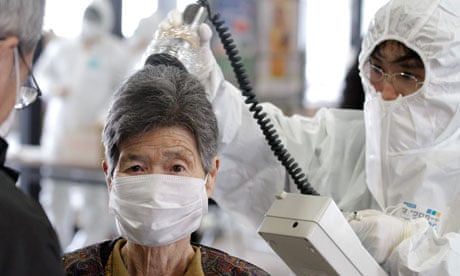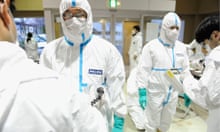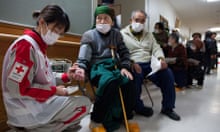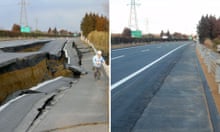Thursday 17 March

1.13am: The US will send a high-altitude unmanned aerial vehicle (so-called spy plane) equipped with infrared sensors, which detect heat, over the plant to help determine what is happening inside, Kyodo news agency reports.
8.48am: Two military CH-47 Chinook helicopters begin dumping seawater over No 3 reactor. At least four loads of 7.5 tonnes are dropped in the first 10 minutes, but TV footage shows much of it dispersing in the wind. Tepco says the spent fuel pool at No 3 reactor is nearly drained of it 2,000 tonnes of water.
10.15am: The IAEA issues a summary of injuries at the Fukushima complex: two people are missing, 23 are injured and more than 20 people have been exposed to significant radiation.
11.24am: Tepco says pressure is rising again at reactor No 3. Officials hope a new power line can provide electrcity to help pump water again.
5.37pm: Three of the six reactors are now relatively stable, officials say; the other three are not.
8.01pm: A truck-mounted water cannon has been dousing the overheating No 3 reactor, Reuters reports. An earlier attempt was defeated by high radiation levels – this subsequently dropped. Some reports say 11 trucks have been deployed.
Wednesday 16 March

5.45am: Fire discovered at northwest corner of unit 4 reactor building.
6am: Abnormal noise from one of the plants. Tepco evacuates non-essential staff at the power station leaving 50. It says: "We sincerely apologise for the great distress and inconvenience this incident has caused."
11:10am: A fuel pool at the No 3 reactor at the Fukushima Daiichi plant may have heated and produced steam, Tepco says. Earlier media images showed white smoke drifting from the plant.
11.30am: It is not realistic to think the No 4 reactor at the plant will "reach criticality", the chief government spokesman says.
1.27pm: Japan's nuclear safety agency says operators of the damaged nuclear plant plan to bulldoze an emergency route to the facility to allow access for fire trucks.
4.55pm: Tepco (Tokyo Electric Power company) says it has recorded the highest levels of radiation yet at Fukushima Daiichi plant's troubled No 3 reactor.
5.26pm: Tepco says soaring radiation levels mean personnel have been withdrawn from work to cool reactors.
6.14pm: First attempt to use a Japanese air force helicopter to drop water into the No 3 reactor fails as the craft is unable to get close enough due to the high radiation levels, says Kyodo news agency, quoting the defense minister.
7.53pm: Japanese police announce plan to try to cool the spent nuclear fuel pool at the No 4 reactor using water cannon. American specialists says the spent fuel pool has lost all its water, which would cause the rods to overheat and emit even more radiation.
Tuesday 15 March

6.10am: Explosion at unit 2 damages the roof of the reactor building of unit 4. This may have damaged the containment vessel at unit 2.
9.01am: Radiation surrounding the plant has risen fourfold since the explosion, Tepco says.
9:38am: A fire was discovered on the third floor of the secondary containment building of unit 4.
11.08am: Risk of nuclear leakage is rising, Prime Minister Naoto Kan says, and warns people within a 30km radius to stay indoors. Those within 20km of the plant have already been told to evacuate.
11.41am: Radiation levels in Kanagawa prefecture, west of Tokyo, are up to nine times the normal level briefly on Tuesday, Kyodo news agency says, quoting the prefecture government.
12:29pm: Tepco confirmed that the fire at unit 4 had been extinguished.
2pm: Radiation levels in Tokyo are "not a problem", the city government says.
2.07pm: A no-fly zone is established for a 30km radius around the plant, Jiji news agency says, quoting the transport ministry.
6.2pm: Japan's nuclear safety agency says there are two holes of eight metres square in a wall of the outer building of the quake-hit Fukushima Daiichi No 4 reactor after a blast in the morning.
8.50pm: The radiation level in the Japanese capital, Tokyo, is 10 times normal, but there is no threat to human health, the city government says.
Monday 14 March

7.29am: Tepco says it has reported a rise in radiation levels at its Fukushima Daiichi nuclear power plant to the government.
11.01am: Explosion followed by white smoke at unit 3. Tepco says it is believed to be a hydrogen explosion. "It is estimated that the reactor containment vessel remains intact. However, the status of the plant and the impact of radioactive materials to the outside environment are presently under investigation."
12pm: Tepco says six workers have been injured in the explosion.
12.43pm: Edano says a large-scale radiation leakage is unlikely from the Fukushima Daiichi plant's No. 3 reactor hit by an explosion after cooling problems.
1.30pm: Tepco updates the number of injured workers to seven.
3.17pm: Jiji news agency reports there has been an explosion at a fuel oil tank at a thermal power plant in Fukushima and that the tank is on fire. It is not immediately clear which company the thermal power plant belonged to.
4.17pm: Edano confirms water levels at the Fukushima Daiichi plant No 2 reactor are falling and its cooling functions have stopped.
7.52pm: Jiji news agency quotes Tepco as saying nuclear fuel rods at the Fukushima Daiichi complex's No 2 reactor are now fully exposed. Jiji says a meltdown of the fuel rods cannot be ruled out.
8.10pm: Water levels inside the Fukushima Daiichi complex's No 2 reactor are almost empty, Tepco says. Jiji news agency says the operator of the plant has started injecting sea water to the reactor in the hope of cooling it down.
Sunday 13 March

3am: The IAEA director general, Yukiya Amano, offers his condolences to the people of Japan. "Japan has many nuclear power plants and most of these are either unaffected or have shut down safety showing the effectiveness of the safety measures."
5.41am: In a 20km radius around the Fukushima Daiichi complex, an estimated 110,000 people have been evacuated, the IAEA says. In a 10km radius around the nearby Fukushima Daini complex, about 30,000 people have been evacuated.
6.20am: The number of individuals exposed to radiation from the Fukushima Daiichi complex could reach as high as 160, an official of the Japan Nuclear and Industrial Safety Agency warns.
11.37pm: Jiji news agency quotes Tepco as saying it is preparing to put sea water into the No.2 reactor at its Fukushima Daiichi nuclear power plant. The company is injecting sea water into units 1 and 3.
Saturday 12 March

1.46am: Jiji news agency quotes Tepco as saying pressure inside the No 1 reactor at the plant has been rising, with the risk of a radiation leak. It plans to take measures to release the pressure, the report says.
3am: Tepco says the company has decided to vent steam in order to release pressure. "We have decided to implement measures to reduce the pressure of the reactor containment vessel for those units that cannot confirm certain level of water injection by the reactor core isolation cooling system, in order to fully secure safety."
6am: Tepco indicates for the first time that radiation levels at the Fukushima Daiichi plant are rising.
7am: Tepco says evacuation has been ordered: "Evacuation has been instructed by the national government to the local residents within 10 km radius of Fukushima Daiichi nuclear power station and Fukushima Daini nuclear power station."
7.19am: Tepco says it has lost its ability to control pressure in some reactors of a second nuclear power plant at its Fukushima facility.
3pm: Tepco indicates that one of its workers has received a radiation dose higher than the recommended limit.
3.36pm: Large explosion at unit 1 of the Fukushima Daiichi nuclear plant.
5pm: Tepco indicates that radiation levels at the plant are rising.
5.47pm: Edano confirms an explosion and radiation leak at Fukushima Daiichi. "We are looking into the cause and the situation and we'll make that public when we have further information," he says. "At present, we think 10 km evacuation is appropriate."
8.43pm: Edano says: "We've confirmed that the reactor container was not damaged. The explosion didn't occur inside the reactor container. As such there was no large amount of radiation leakage outside. We'd like everyone to respond calmly."
10.21am: The International Atomic Energy Agency (IAEA) quotes Japanese authorities as saying they are preparing to distribute iodine to people living near the stricken nuclear power complex. Iodine can be used to help protect the body from radioactive poisoning.
Friday 11 March

2.46pm (5.46am GMT): 8.9 magnitude earthquake hits at 2.46pm (5.45am GMT), about six miles below sea level and 78 miles off the east coast. Minutes later, a tsunami wave of up to 10m reached the north-east coast of Japan.
4.30pm: The Tokyo Electric Power Company (Tepco) announces that 4.04 million households are without power because of the quake. It says units 1, 2 and 3 at the Fukushima Daiichi nuclear plant and units 1 to 4 at Fukushima Daini stopped automatically because of the quake.
7.46pm: The government reveals a cooling problem at Tepco's Fukushima Daiichi plant on the north-east coast, which bore the brunt of the quake and tsunami. The chief cabinet secretary, Yukio Edano, says the government has declared an emergency as a precaution but insists there is no radioactive leak.
11pm: Tepco press release: "Survey data on radiation by exhaust stack monitors and monitoring cars has indicated no departure from normal level for all nuclear power stations."






